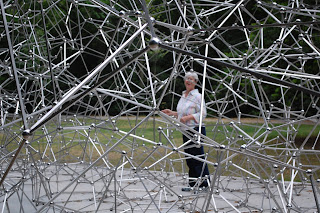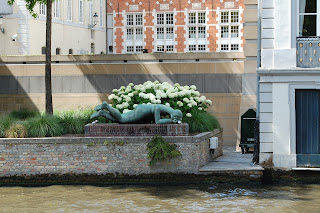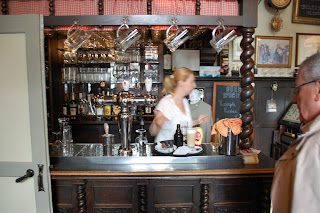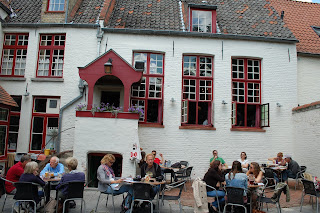We began our ten-week tour in
Denmark since it was the last days of the
Sculpture by the Sea exhibition in
Aarhus. But first we took a quick tour around
Copenhagen.
 |
| Sculpture by Steinunn Thorarinsdottir. |
The Cisternerne Museum is a former underground water reservoir beneath Søndermarken Park which is no longer strictly for exhibitions of glass art. This, of course, gives them more flexibility. The show we saw was called
H by
Ingvar Cronhammar.
 |
| H by Ingvar Cronhammar |
A visit to the
Statens Museum for Kunst - the national art museum - is a good way to get started. Seeing old friends:
 |
| Fertilization on the Borderland Between Good and Evil by Ejler Bille, 1933 |
 |
| The Green Blouse by Henri Matisse, 1936 |
And noticing new artists, especially Germans, such as:
 |
| Max Ernst |
 |
| Legend by Emil Nolde, 1932-39 |
After picking up a car, we drove west, then north to
Aarhus, the second largest city in Denmark. Considered a university and art town. As anyone following our blog may recall, the
Sculpture by the Sea exhibition began at Bondi Beach in Sydney, Australia. But when the prince of Denmark married an Australian beauty, Denmark began its own version of the biennial event, though still run by the Australian organizers. It was a magnificent day and though the last Thursday of the month-long show, there were lots of art-goers and sun-bathers.
 |
| Hello Golem by Savako |
 |
| Diamonds by Michael Motycka |
There were fifty-six works of Art in the water, on the shore, and in the adjoining woods. Fantastic.
 |
| Skin Cube by Louise Sparre |
We spent that night in the south of Denmark in
Tinglev. And little did I realize that the apartment we rented, on a farm-like place, was upstairs from an art gallery -
Galleri Nexus.
After we got settled, owner
Kent Lauritsen opened up the gallery for us to nose about, which was great fun. He was closed for the season, apparently, but he had a wonderful selection of contemporary and historical pieces, as well as stories about local artists:
Harald Lauritsen, who was shunned during WWI,
and
Emil Nolde who was born Emil Hansen, in the town of nearby Nolde, and decided to take that name since there were already too many Hansens.
The next day we headed into Germany in search of a couple of sculptures by
Niki de Saint-Phalle across the river from
Hamburg. Got thoroughly lost in an industrial maze and then came out in cherry orchard country.
We stopped for some to eat while trying to get directions to Bremen.
A brief stop in
Bremen:
 |
| Swineherd and his flock by Peter Lehmann, 1973 |
 |
| Roland |
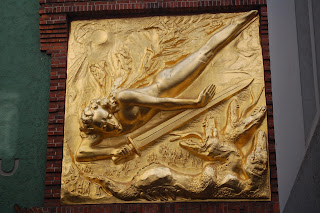 |
| Entrance to Boettcherstrasse: Der Lichtbringer Bringer of Light by Bernard Hoetger, 1936 |
 |
| Another Hoetger |
 |
| Miessin porcelain
bells |
We continued to
Mettingen, where we were staying that night. It was also time for their
Shützenfest (they have them all over Germany). Obviously an event involving shooting, it began in the middle ages as a competition for local militias, but has evolved into a reason for men to get away from their wives one night per week. (Or is it an excuse to get the men out of the house?)
As we arrived we could hear a band playing so I ran down the road to the beginning of the parade which consisted of one band, one horse-drawn carriage, and a whole lot of men in white shirts marching. They were heading for the nearby clubhouse and grounds where the ceremony and celebration would be taking place. Earlier they had all shot at an artificial bird in an artificial tree. The one who knocked it down became King for the year. Our host, Alfons, was the out-going monarch, so we were introduced to all the dignitaries. The joke going around was that I was from the New York Times. We drank a toast with what was probably a cherry liquor. Not as harsh as slivovitz, ouzo, or calvados.
 |
| Alfons |
The house we stayed in was breath-taking inside and out, and has been in Alfons' family for many, many years.
Next stop: the Kröller-Müller Museum in The Netherlands. It is located in the Se Hoge Veluwe National Park and thoroughly difficult to find. But definitely worth it. Founded by art collector Helene Kröller-Muller and opened in 1938, it has the second largest collection of paintings by Vincent van Gogh, after the Van Gogh Museum.
 |
| Self-portrait by Vincent Van Gogh, 1887 |
 |
| Terrace of a cafe at night (Place du Forum) by Vincent van Gogh, 1888 |
And there are lots of other artists represented here as well. Notably, Jan (father) and Charley Toorop (daughter).
 |
| Self-portrait in front of pallette by Charley Toorop, 1934 |
 |
| Fatalism by Jan Toorop, 1893 |
Also lots of Odilon Redon, Jean Metzinger, and more.
Then it was off to Amsterdam, an hour and a quarter to the west. Rather than stay in the city proper, we found an apartment south of town in Amstelveen, a separate city, with its own art museums (CoBrA & Museum Jan van der Togt, which we had visited previously) and canals.




Free parking in Amsterdam on Sundays, so we drove in and found parking near the Van Gogh Museum first thing. This is, of course, the newer incarnation which we had seen twice, many years after visiting the old museum, which we liked very much.
The big crowd quickly filled the galleries, forcing us to flee to an upper level, but that didn't matter since the new display takes VVG's paintings out of chronological order. Now they are grouped with work by contemporary artists, or with new art addressing some bogus project the curators came up with. These gimmicks were a massive distraction from the obvious fact that there are less of his better paintings hanging in this museum than the old one, and probably fewer than we saw on the two previous visits to the new museum. The ground floor had a bunch of self-portraits that I did not remember there. The other floors were usually difficult (well, at least "not easy") to navigate with too many pieces by others. Having been here before, I didn't take any pictures this time.
From there we walked across the grassed expanse of the Museumplatz to the Rijksmuseum - the national museum of The Netherlands. In 2013, it reopened after a ten-year renovation costing 389 million Euros. I wish I could say it was worth it. And yet it was named European Museum of the Year.
 |
| Rembrandt's The Night Watch, 1642 |
Of course, they do have paintings by native sons, from Vermeer to Appel.
 |
| The Milkmaid by Johannes Vermeer, c1660 |
 |
| The Encounter by Karel Appel, 1952 |
Outside was a delightful exhibition of Miro sculptures.
 |
| Oiseau lunaire by Joan Miro, 1966-1983 |
And then it was off to explore the Art that is Amsterdam:
CLICK HERE FOR MORE.
We began the day north of the city at a place called Zaanse Schans. Located on the Zaan River, it was once fortifications (scone), built beginning in 1961 an array of windmills, some from the 1500s, have been reconstructed along with thirty-five houses from around the region. It is not a major tourist attraction, but still fun if you get there before the crowds.
 |
| Marie on a kippenbruggen. |
Zuid means "south" which is the part of Amsterdam where we found this sculpture exhibition.
Architect H.L. Berlage strove to develop this area since 1904. It was finished in 1926-27 just in time for the 1928 Olympic Games. (These Olympics, by the way, featured official competition in Art, as well as Athletics.)
We found the parkways filled with sculptures.
 |
| Duna by Jaume Plensa, 2014 |
 |
| Mermaidsmischief by John Chamberlain, 2009 |
And the roadways lined with interesting architectural detail.
We got to Aalmsmeer by 7:30, because you have to get there early before all the flowers are sold and shipped off. But we saw only a couple of other tourists as we walked along the catwalk over the largest flower market in the world.
 |
| Neat shot, huh? |
By nine we were on the road to Rotterdam to see Ossip Zadkine's masterwork, The Destroyed City. In 1946 the French sculptor visited the city leveled by the war. He dedicated his statue in 1951.
This statue which everyone calls 'The Destroyed City.'
Whenever I see it in Rotterdam, I become more and more a foreigner to the city.
All round it monstrous skeletons arise every day, new plants of our future tomorrow,
and the statue
appears to me to be retreating backwards to be where the quiet waves
of the harbor are waiting
The steel dinosaurs cannot bear it.
But when I look upon it in my garden under the trees
and there millions of leaves,
I seem to hear its 'nevermore', it screams of pain and despair.

We found Art and other things in the neighborhood.
 |
| Apollo by Olaf Nicolai |
 |
| the Marine Band of
the Royal Netherlands Navy |
CLICK HERE FOR MORE.
Antwerp is just south of the Belgian border. And Middelheim is just south of Antwerp. There we found sculptures at the University of Antwerp/Middelheim campus and the Middelheim Sculpture Park
We found our way to the almost hidden entrance of the Middelheim Museum which is primarily an open-air sculpture museum. The collection contains more than 400 pieces assembled over the past fifty years. All dates from 1900 to present, as new pieces are always being added.
It was wonderful how we'd see so many artists whose names we didn't know and suddenly come across work by Henri Laurens, Renoir, Rodin, Maillol, or Anthony Gormly, Barbara Hepworth and Louise Nevelson.
Heading out of town toward Brussels, we came upon the sculptures of the
University of Antwerp/Middelheim campus.
 |
| Bow Knot by Shinkichi Tajiri, 1994 |
 |
| Lucifer by Paul Van Hoeydonck, 1994 |
 |
| Schenking van E. de Jaeck by Camiel van Breedam, 1938 |
And finding our way through the City:
To our place outside Brussels, in
Roosdaal. From there we would visit
Brussels,
Bruges,
Ghent, and
Mons. The next day in Brussels we were informed that the Modern Art sections of the
Royal Museum of Fine Arts was "unavailable." So instead we spent the morning dodging raindrops and checking out the city.
 |
| Musical Instrument Museum designed in 1899 by Paul Saintenoy |
 |
| Head in the Clouds by Suzanne Groothuis |
 |
| Nathanael Neujean |
 |
| Bela Bartok |
|
 |
| Yoko Tsuno Straat |
 |
| Cuberson or Neus (nose) in Dutch |
 |
| Olivier Rameau by Danny & Greg |
 |
| Mondrian may have done something here. |
And then there is Brussels' pièce de résistance:
Next we found the Museum van Buuren in an up-scale residential neighborhood, which makes sense as it was the home of David and Alice van Buuren.
Built in 1928, the exterior is typical Amsterdam School, while the inside is Art Nouveau of several interpretations. They filled their home with unusual artistic objects from pillows designed by Sonya Delaunay to a piano belonging to Erik Satie (rosewood, designed by Julius Bluther), as well as an assortment of paintings, sculptures and leaded glass. Major Belgian artists from Pieter Bruegel the Elder to Kees von Dongen, and Van Gogh (who spent some time in Belgium). Van Buuren was a patron of Belgian expressionist painter, Gustave van de Woestijne, and the collection has thirteen of his paintings. Became Museum van Buuren in 1975. Photos were not allowed, but I found these online:

 |
| Satie's piano |
 |
| Painting by Gustave van de Woestijne. |
In 2013 paintings by old masters, Von Dongen, and Ensor were stolen and not recovered.
 |
| The Thinker by Kees von Dongen, 1907 |
The garden is a major attraction, is three gardens. One features a series of sculptures by
Andre Willequet.
Next we visited the focal point of the 1958 Brussels World's Fair,
The Atomium.
 |
| RockGrowth 808 by Arik Levy, 2014 |
Designed by the engineer
André Waterkeyn and architects
André and Jean Polak, it stands 335 feet tall. As a side note to this, when but a child, Marie entered and had accepted a poster that was displayed at this fair. On even more of a side note,
Benny Goodman recorded the much decorated
Sing, Sing, Sing Live in Brussels there as well.
Close by were remains from the 1935 World's Fair.
 |
| Heizel Paleis former Palais du Centenaire |
Next day we spent in Bruges. This well-preserved Medieval city, sometimes known as the Venice of the North, has a wealth of Art to offer. For example, greeting you at the bus station is this piece by Stefaan Depuydt and Livia Canestraro:
We were there for the
Triennale, which featured pieces of Art and Architecture all around the city. Here are a few we found:
 |
| Doing Nothing Nothing Doing by Song Dong, 2015 |
 |
| 1-1 Connec-DiamondScope by Vibeke Jensen, 2015 |
 |
| It's Kunst! |
 |
| Canal Swimmer's Club by Atelier Bow-Wow |
 |
| Cataract Gorge by Romy Achituv |
 |
| Bridge by the Canal by Studio Mumbai |
And, of course, there was other Art in evidence:
 |
| Papageno - from Magic Flute - by Jef Claerhout |
 |
| Frank van Acker by Fernand Vanderplancke |
 |
| By Carlos Mata |
 |
| To Frank van Acker by Stefaan and Livia. |
 |
| The Four Horsemen of the Apocalypse by Rik Poot, 1924 |
But perhaps the highlight of the day was the desperate discovery of the
Cafe Vlissinghe and its tap of
Leffe Brune.
They were celebrating their 500th Anniversary, so we were happy to join in. Here are some pics I took matched with old photos found later.
And a few parting shots.
Mons was a
European Capitol of Culture in 2015, so we made it part of our trip. We did, however, have great difficulty in finding any of the promised Art. Perhaps a disappointment. Here's a little of what we did see:
The museum had some interesting examples:
 |
| Portrait Double Face by Gaston Chaissa |
 |
| Yves Lecomte |
Ghent or Gent was just an hour away. Old and interesting. We began at Citadel Park where we found the
MSK (
Museum voor Schune Kunst - fine art).
A variety of artists, period, styles, and much to like. From some interesting Bosch, Rubens, Van Eyck, and Breughel to the German Expressionists and Abstract artists. There was an exhibit explaining how the famous altarpiece done by both Van Eyck brothers was a turning point in art history; how it is being restored; and that other panels were still in the church.
 |
| Collecting Engravings by Honore Daumier, c 1879-73 |
 |
| Four Nude Girls in a Boat by Edgard Tytgat, 1960 |
Then to the neighboring
SMAL (Stedelijk Museum voor Actuele Kunst
- contemporary art). Less to find appealing. Show was called
Folds in Time.
 |
| Folds in Time by Lili Dujourie, 2015 |
There was a Sol LeWitt wall drawing, but too faint to photograph well. Then it was off to the old town.
 |
| Gravensteen Castle |
 |
| Graffiti Jam - Werregaren Straat |
 |
| Honest Arts Movement |
Next stop:
Germany (click here)



























